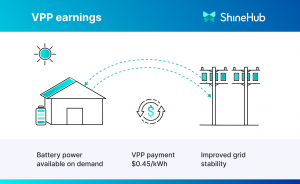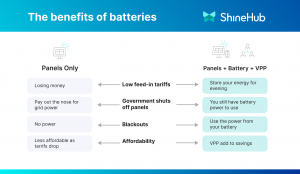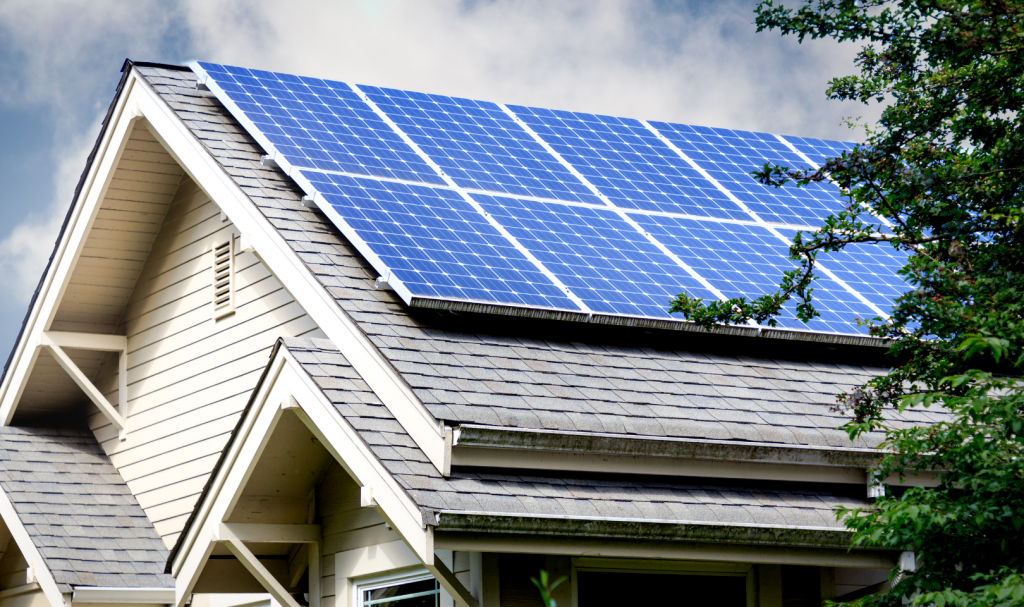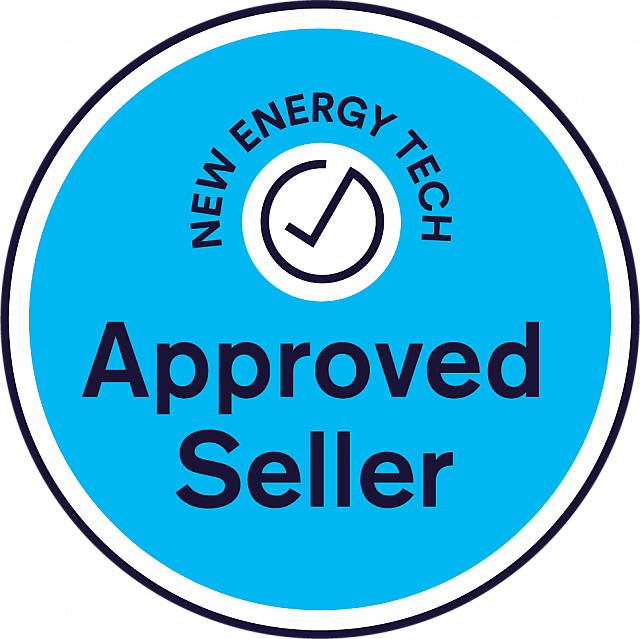You’ve seen the headlines. Claims that solar is crashing the grid are plastered across the press. Solar “experts” pop up on TV to tell you that the government needs a kill switch to control your solar panels. Daytime solar feed in credits are falling every year. And in 2025 solar panel customers may be charged for sending power back to the grid during the day.
If that scares you, we get it – the whole point of going solar is to be in charge of your own power. Hearing that the powers that be can change the rules and throw you to the mercy of the grid is alarming to say the least.
So, is there something happening here? Or is it just a lot of media hype? In this article, we’ll lay out the facts so that you know exactly what’s going on and how to make sure that your system is future-proof so you always get the maximum benefit.
We’ll also explain how installing a solar and battery system in your home can actually help to stabilise the grid for everyone – while you get paid for helping stabilise it at night.
These changes might sound scary, but with the right system you can turn the tables in your favour and actually make extra money! If you want to make sure you’re set for the future, have a browse and shop for solar online.
Is Solar Destabilising the Grid?
Have we seen it happen? Yes. Is it a common problem? No… not yet anyway. Does it have the potential to be a bigger problem in the future? Yes. Is there a solution? You better believe it! And the best thing is, being part of that solution can actually earn you money!
So, what’s actually happening? Basically, as a result of the sudden boom in residential solar, there is a huge amount of power being pumped back to the grid every day from rooftop panels. This is mostly a good thing, but sometimes the surge of power is more than the grid can handle. In those circumstances, the grid needs a way to protect itself.
This can be achieved by simply shutting off panels, and that’s what these so-called “experts” are talking about. It’s also the reason that solar feed in credits are falling – they don’t need the extra power during the day.
But there is a new method which will only get more and more popular in the future – To learn more about how this work, read more about Virtual Power Plants or check out the direct benefits you can get from the ShineHub VPP here.
Batteries – The future of home solar power
First and foremost, you need a battery. In the good old days of the solar boom, the credits you’d get when your panels sent power back to the grid (the feed-in tariffs) were enough to cancel out your bill.
But as residential energy becomes more widespread, those tariffs have already been slashed – and they’re crashing more and more as time goes on.
Add the threat of your panels being shut off during surplus times and the ever-present possibility of blackouts, and it’s clear that this is a problem that calls for a smart solution.
That’s why solar batteries are more important than ever. If you have a solar battery in your home, you store extra power during the day instead of giving it away in exchange for shrinking solar credits. That means that you get to use the power yourself, ensuring you get the full value of the power your home produces.
Thinking about getting a battery? Check solar battery prices here.
The Future of Home Solar Power is People
Escaping grid prices is only the tip of the iceberg! If you have a battery that can link up with a Virtual Power Plant, you can actually generate profits for yourself during those times when the grid becomes unstable.
Rather than resorting to grid power when the panels get shut off, you’ll actually get paid a premium rate to charge your battery from the grid. That’s because the grid has too much power in those times and needs somewhere to put the excess. But the upshot is this: you get paid to charge your battery. Who doesn’t want money and power!
When you link your battery up to a Virtual Power Plant, you get to be a power player. If the grid has too much energy, you’ll charge your battery from that excess. If the grid needs more power, some of your excess power will be diverted to the grid. And the best part? You get paid either way! And not just the feed-in tariff. You get paid at a premium rate far higher than the standard tariff alone.
Battery + VPP = Freedom
When you get down to it, it’s all about managing power as it moves back and forth between your home system and the grid. There are basically three ways this can go depending on the components of your solar setup:
- Just Panels = If too much power is flowing to the grid from residential solar, the government could temporarily shut off solar panels.
- Panels + battery = If too much power is flowing to the grid from residential solar, the government could temporarily shut off solar panels, but you can continue to use the power you’ve stored in your battery.
- Panels + battery + VPP = If too much power is flowing to the grid from residential solar, the government could temporarily shut off solar panels, but you can continue to use the power you’ve stored on your battery. On top of this, you’ll be paid $0.45/kWh + the solar feed-in tariff for discharging energy to the grid.
As you can see, VPP participants help the grid stay balanced whether they’re drawing power from it or sending power to it. When the grid needs more power, a Virtual Power Plant can activate and send some off at the press of a button.
When there’s too much power and the grid needs to get rid of some, household batteries can be charged up from the grid. For providing that service, each participant receives premium payments that become a source of passive income.
It’s important to make sure your battery can connect up to virtual power plants without additional costs involved. VPPs can be very different in how they work, how you sign up and what they offer you in return – you can read more about that here or see your direct benefits from a VPP here.
Are Solar Batteries Financially Viable?
The short answer? Yes!
Okay, here’s the long answer. You’ve no doubt heard – probably from those “experts” we mentioned before – that batteries are too expensive to be viable at the moment. “Wait for the price to go down,” they say. But let’s look at the actual numbers.
Next time you see an article like that, check the price point they’re estimating for household batteries. Usually, they’re talking about batteries that cost about $15,000 or so. Here’s the thing, – most of the batteries we sell at ShineHub retail at around $5.5K to $9.5K. That’s a big difference.
On top of that, we have bundles such as the Powow PPA available for a low monthly price including all upkeep and maintenance.
With some of our customers zeroing out their power bills or even sending them into credit, it’s easy to see that batteries have already become financially viable for many households!
We’ve got news for the “experts” – home batteries are here, and they’re saving real money for real people!
Check out battery prices here.
How Can I Protect Myself from Big Brother?
The moral of the story is this: If you want to protect yourself against future policies, grandfather yourself in now! For the most part, new policies only affect future installations and are not retroactive. That’s why it’s important to act now, install a smart future-proof system, and join up with a Virtual Power Plant like our ShineHub Community VPP. Learn more about our VPP here.
Currently, South Australia is the most vulnerable state when it comes to this issue. The SA government has already authorised rooftop solar systems to be shut off on rare occasions as an emergency intervention. But the key point to note is that this will only affect households who went solar in SA after 28 September of 2020.
And if you have a battery and VPP, you’re safe! Since you’re not relying on feed-in tariffs from the grid and can use your battery power during shut-off times, you’re insulated from the effects of this policy.
As you can see, ensuring you have the right system is key for safeguarding the maximum benefits of solar power. The combination of a home battery and enrolling in a VPP not only protects you if the government temporarily shuts off your panels, it can actually create passive income for your household and help to stabilise the grid!
That’s good news for you, your family, and your community. Plus it will help Australia move towards a more sustainable future!
Avoid getting trapped in changing energy policies and rising power prices — shop solar online today and protect yourself over the long term.




